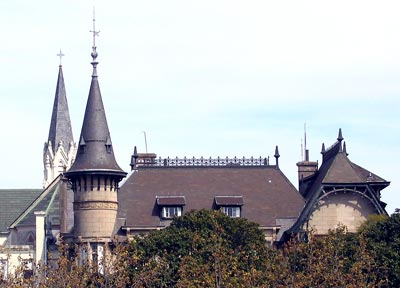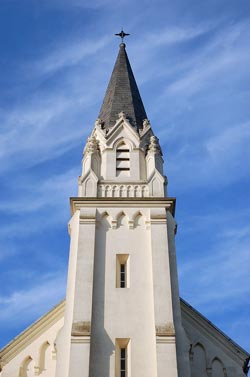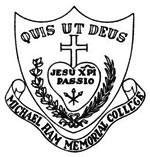|
When the Passionist sisters arrived in Argentina and founded Michael Ham Memorial School in 1926, little did they imagine the strong impact they would have on education in the country. They were not more than a dozen Catholic, spirited women with a strong conviction that their mission was to expand the faith and teach, with only the Bible and their own Saxon education as tools.
They lived and transmitted the Passionist motto:
'Devotion to the Passion, Death and Resurrection of Christ', and they also dedicated themselves wholeheartedly and with joy and passion to teaching.
'It was the Irish sisters who gave the school its informal, progressive and joyous spirit' (Old Girls Bulletin, 1979: 20). Mysteriously, the spirit of the Sisters silently grew among the students. And so, a school with no pedagogical subjects, where neither Teaching Skills, Accountancy, nor Psychology were taught, would, in time, become an incubator for hundreds of former pupils dedicated to teaching and education.
How and why did this happen?
Bloom where you are planted
Even though the Passionist motto is not especially devoted to education, the sisters taught with body and soul. (1) They undertook their mission with seriousness and their own innovative originality. They taught History, Literature, Scripture, Politics (I especially remember the book
'Our Democracy' which Sister Cyprian used, it was really
'their democracy', while we had little democracy!), Cooking, and so on. They also organised operettas, encouraged sports and dancing, and believed that learning was fun. They taught us to be original, to build our own ideas, to look for answers not written in books, to look beyond ourselves, and to look at the person right next to us. They planted in us a spirit of searching, of questioning, a spirit of how to improve the world.
It came to be with time, that in some cases this spirit mingled with the famous proverb
'necessity is the mother of invention'. Many former pupils felt needs (their own, and those of society) and instinctively gave an answer: to get involved in education.
In the case of former pupils who had to emigrate to the provinces to follow their husbands, they found that there were no appropriate schools to educate their children. They wanted religious, bilingual schools, and they longed for a cultural education similar to the one they had received themselves. That was the origin of San Pablo Apóstol, in San Martín de los Andes (province of Neuquén), Santa María in Salta (province of Salta), Holy Trinity College in Mar del Plata (province of Buenos Aires), and San Antonio in Concordia (province of Entre Ríos).
In some way the story repeated itself; in the early twentieth century most of the Irish immigrants who arrived in Argentina were well educated and wanted a religious, bilingual education for their children (Roger, 2003:1). At that time, the majority of the Irish-Argentine schools were linked to religious orders. In the late twentieth century many religious orders were dwindling in vocations, or had even disappeared. But their spirit had somehow flourished in their pupils. And so, Argentine women who had been educated by Irish and English nuns decided to found schools where they were ‘planted’.
In other instances the need was related to the expression of a teaching vocation, or an economic need. When Michael Ham was originally founded, the girls
'were taught to sew and embroider, French, manners, piano and singing; in some cases, they also performed Irish dances' (Roger, 2003:1), while at other community schools, boys were better educated for jobs. That is why many girls were not always expected to follow university careers as they are today. If they wanted to work, or needed to work, they definitely knew how to teach, and how to organise. That is the origin of many of the other schools founded by former ‘Michael Hammers’.
Starting in the 1950s, former pupils founded schools and English Institutes all over Argentina, and especially in Buenos Aires; all these schools are emblazoned with the house colours
'red, blue and yellow'. After exhaustive research I have found that old Michael Hammers have participated in the foundation of 17 schools, from Salta Province to Neuquén. Most of these schools are more than twenty years old, and have already seen many classes graduate from their academic halls.
Old Girls have participated in the creation and organisation of three non-profit Educational Programmes, eight English Institutes and four Kindergartens (see inset 1). More than 50 former pupils have been, or still are, headmistresses in different schools (see inset 2). But if we dig further into society their presence in education goes well beyond this. Thousands of former pupils have taught at some stage of their lives (generally English). To give just one example, in my group of former pupils 70% have taught or are still teaching. As Victoria Zorraquín (a double founder) said
'The opportunity we as Michael Ham pupils had was unique, we were at the Mecca for any educator'. (2)
With regard to new schools (see inset 1) these Old Girls spread the spirit and spirituality of our school. They filled empty spaces with effort, and the heritage, sometimes unconsciously acquired, of what we had learnt at school, from our Irish (and a few English) sisters. María Moreno told me
'Our school was named Holy Cross for our Passionist Sisters, with the following motto in the badge “By thy cross You redeemed the world”.' Visiting the web pages of these schools we will also discover that social work is a central and distinctive aspect in the school’s mission statements.
It is marvellous to see the three colours strewn all over the country as many schools, like Holy Trinity, San Pablo Apóstol, and Saint Mary of the Hills, chose those house colours. Other founders, like Tolo Zorraquín, decided to leave the
'Blues' out (in her time blues always won the cups, and she was yellow), so she has reds and yellows, and Ana Fitte in agreement with the staff decided on reds, blues and greens (even though she was also yellow). I have been to some sports and seen pupils march to the very same tunes we did (Bridge Over the River Kwai).
It was also very moving to read the numerous accounts of the school founders, which I could sum up as
'In many ways we are a “mini” Michael with the changes of our times'. (3) And I dare to add, not so mini, as most of these schools have over 600 pupils nowadays.
The importance of the work of the Passionist nuns, the far-reaching and multiplying effect of their simple but well-prepared classes (with no computers or Powerpoint presentations, no self-improvement courses, no gas heating, but open to creativity, novelty and mind development) is undoubtedly their great legacy to our country. Today they are dedicated mostly to charity work, in accordance with their mission. (4) But the unthought-of creative objective of their work arises like an unexpected gift, alive, prolific and in constant growth. (5) Sister Gerardus used to say
'The eye of God is upon us!' and Susana Soler adds 'and the Spirit of the School is inside us'. And it has undoubtedly bloomed.
As a conclusion, I quote Sister Patricia Carney’s words: (6)
'I became convinced that educating in Michael Ham was a very important apostolate: we were multiplying the number of people who could go out and reach people we could never reach. That’s what all these past pupils are doing - literally going out to the frontiers and giving an excellent education to children who would not get one, or at least not as good a one. You are our hands carrying on our mission in the places we can’t get to, sharing the education you have received.'
Damasia Becu-Villalobos
Notes
1 Elizabeth Prout, Mother Mary Joseph, the founder of the Passionist nuns, started her apostolic activity in Manchester, teaching girls of the working class, in hostels and schools. Her idea was that access to education would be the key for their progress in life.
2 Personal correspondence.
3 Magdalena Ortiz, personal mail.
4
Hermanas Pasionistas, website (http://www.hermanaspasionistas.org.ar/historia1/07.htm).
'In that process the nuns have deposited in lay people the work of the school, always helping in the fundamentals: the living and deepening of the Mission of the Order. In this way the School will not lose the “stamp” left by the nuns in 73 years of active presence in the classrooms.'
5 Becu, D.,
La comunidad pasionista, website (http://www.irlandeses.org/education.htm)
6 Michael Ham Memorial College
- 75th Anniversary (Buenos Aires, 2001), p. 21.
7
'They mingled with us [...], spoke our language,
celebrated our triumphs, cried with us [...] while we
were captivated and transformed by them. Our deep and
joyous religiosity is their gift. Our love for parties,
the organisation of events, the songs ... our love of
freedom, of truth, were sown by them. Happy mixture of
cultures! They took our spontaneity, our sensitivity,
and they left us all their joy, spirituality and
discipline!'
References
- Asociación de Ex Alumnas del Colegio Michael Ham, ‘Las Bodas de Oro del Colegio Michael Ham’ in
Old Girls’ Bulletin 3:9 (September 1939), p. 20.
- ‘Historia de las Hermanas Pasionistas en la Argentina’ in
Hermanas Pasionistas en la Argentina. Website (http://www.hermanaspasionistas.org.ar/historia1/07.htm), accessed 18 March 2008.
- Michael Ham Memorial College, 75th Anniversary (Buenos Aires, 2001).
- Roger, María José, ‘The Children of the Diaspora: Irish Schools and Educators in Argentina, 1850-1950’ in
Society for Irish Latin American Studies. Available online (http://www.irlandeses.org/education.htm), accessed 15 March 2008.
|
Founders of schools (7)
Saint Brendan’s, Belgrano: Nelly Durand, 1966.
Colegio Bluebell, Palermo (then Pilar): Patty Sworn, 1973.
Saint Nicholas, Olivos: Diana Mateo and Beatriz Peroni, 1975.
Godspell College, Lomas de San Isidro (then Tortuguitas): Elena Ortiz, 1979.
Saint Mary of the Hills School, San Fernando (then Pilar): Gloria Doheijo, 1979.
Holy Cross, Beccar: Margarín, Mercedes y María Moreno, 1981.
Saint Luke’s, Olivos: Mary Carroll.
Colegio Las Lomas Oral, for the deaf, Lomas de San Isidro: Inés Alvarez, 1982.
Colegio Nuevo Las Lomas, San Isidro: Lucila Krieger Vasena, 1982.
San Pablo Apóstol, San Martín de los Andes (province of Neuquén): Silvia Latkovic, 1987.
Santa María, Salta (province of Salta): Cecilia Devoto, 1988.
Holy Trinity College, Mar del Plata: Marcela Stewart, 1989.
Colegio Confluencia, Neuquén (province of Neuquén): María Robbio, 1990.
San Antonio, Concordia (province of Entre Ríos): Ana Fitte, 1990.
Saint Matthew’s School, Olivos: Mary Moore, 1991.
Colegio San Ignacio, Olivos: Carmen Ball, 1995.
Colegio Río de La Plata Sur, Berazategui: Magdalena Ortiz, 2005.
Foundation and Organization of non-profit Educational centres:
Jardin de Infantes San Pablo de la Cruz: Comisión Directiva de OGAs, 1971.
Centro Madre Maria Jose, Apoyo Escolar: Comisión directiva de OGAS, 1991.
EDUCERE- Programa de actualización docente gratuito para escuelas rurales y urbanas, Buenos Aires, Tucumán, Santa Fe, Santiago del Estero. Victoria Zorraquín, 1988.
|
|
Founders
and directors of English language Schools
Instituto Becú, Ciudad de Buenos Aires: Betty Cárdenas, 1952.
Instituto Steps: Gladys Kenny, 1961.
Instituto Bradford, San Isidro: Beatriz Bradford.
Instituto Choices, San Isidro: Cecilia Feeney. 1989.
Instituto William Blake, Buenos Aires: Clemencia Baraldi,
Shamrock Field School, Florida: Christine Cormack.
Instituto Parroquial Santa Teresa del Niño Jesús, Martínez: Margarín Moreno.
Holy Mary English School, Tandil: Victoria Zorraquín,1991.
|
|
|
|
Founders of Kindergartens
The Clover, San Isidro: Marta Lannardone.
Mother Goose, San Isidro: Eloisa Zavalía.
Boomerang, Ciudad de Buenos Aires: Laura Campomar.
Morning Glory, Ciudad de Buenos Aires: Marcela Richini, 2005.
|
|
|
Former pupils who
became headmistresses
|
Ana Helguera.CP- Michael Ham.
Gemma Harrington CP - Michael Ham.
Caroline Carlisle - Michael Ham.
Denise Norris - Michael Ham.
Alicia Martignoni - Michael Ham.
Mónica Cañellas - Michael Ham.
Cristina Glavina - Holy Cross.
Anne Elliot - Holy Cross.
Irene Brito - Florida Day School.
Carlota Romero -Instituto Labarden.
Peggy Ortiz Machado - St. John’s School.
Magdalena Ortiz - Colegio Río de la Plata.
Elena Ortiz - Colegio Río de la Plata.
María Fernanda Ortiz - Colegio Río de la Plata.
Lucrecia Prat Gay - Colegio Río de la Plata.
Patricia Brunckhorst - Profesorado de Inglés - St Catherine’s School.
Susana Walsh - Depto. de Inglés de la UCA.
Susana Soler - Instituto Bayard.
Denise Norris - Instituto Bayard.
Carol Brewer - Instituto Bayard.
Silvia Castillo - Colegio Los Molinos.
Jennifer Sworn - Sworn Junior College.
Lucía Mayorga - Sworn Junior College.
Inés María Alvarez - Colegio Las Lomas Oral.
Gloria Chafuén - Northlands.
|
Gladys Fernández - Norbridge School Pilar.
Constanza Fantín - Colegio de los Padres, Venado Tuerto.
Analía Vogelius - San Xavier.
Graciela Criado - San Felipe Apóstol, Don Torcuato.
Patricia Criado - San Felipe Apóstol, Don Torcuato.
Alicia Cullen - Colegio de los Santos Padres, Bella Vista.
Marcela Riccini – Bluebell’s Kindergarden.
Carolina Tedín - Santa Teresa del Tigre.
Anne Spangenberg - St. Luke’s, Olivos.
Delia Boucau - Reserva Mamá Margarita de los mapuches, en Malleo Neuquén.
Natasha Zschocke Scian - Shamrock Junior School, Devoto.
Susana Scian - Santa Bárbara.
Christine Cormack - Santa Bárbara.
Patsy Wild - Saint Andrews.
Laura Ordóñez - Jardín del Colegio El Salvador
Mónica Alvariño - Jardín St. Gregory´s.
Ana Massone - Instituto de Arte del Teatro Colón.
Susana Scian - Colegio del Arce
Lizzie Ryan - Colegio del Arce
Susana Soler - Inst. Cultural Argentino de Lenguas Vivas (Tucumán)
Mochita Velarde - Colegio Maryland
Mónica Soplveira de Ramírez - Kindergarden Maryland
|
|
|



